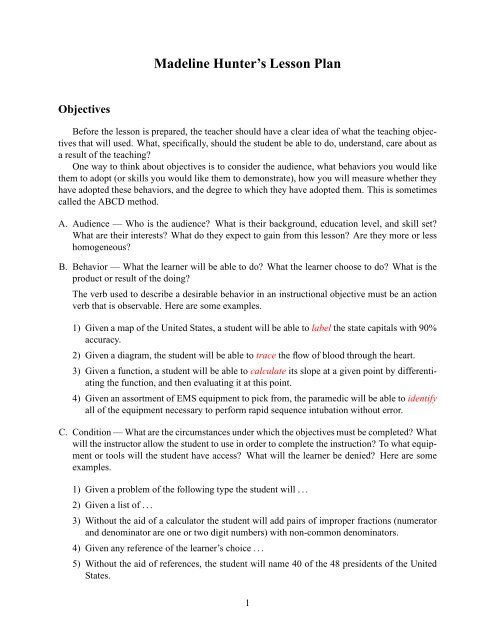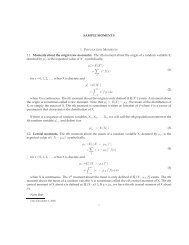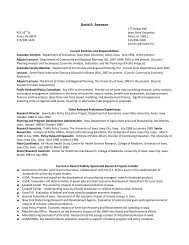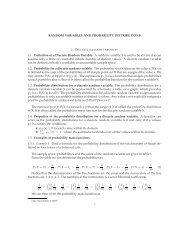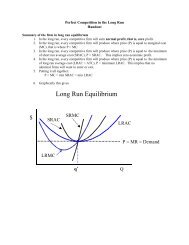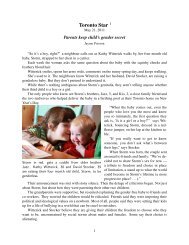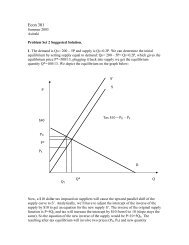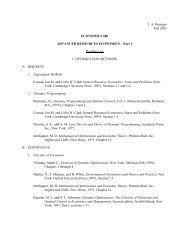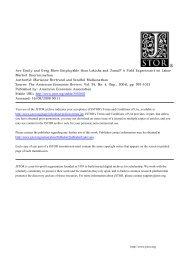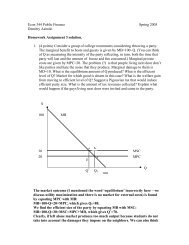Madeline Hunter's Lesson Plan - Iowa State University
Madeline Hunter's Lesson Plan - Iowa State University
Madeline Hunter's Lesson Plan - Iowa State University
You also want an ePaper? Increase the reach of your titles
YUMPU automatically turns print PDFs into web optimized ePapers that Google loves.
<strong>Madeline</strong> Hunter’s <strong>Lesson</strong> <strong>Plan</strong><br />
Objectives<br />
Before the lesson is prepared, the teacher should have a clear idea of what the teaching objectives<br />
that will used. What, specifically, should the student be able to do, understand, care about as<br />
a result of the teaching<br />
One way to think about objectives is to consider the audience, what behaviors you would like<br />
them to adopt (or skills you would like them to demonstrate), how you will measure whether they<br />
have adopted these behaviors, and the degree to which they have adopted them. This is sometimes<br />
called the ABCD method.<br />
A. Audience — Who is the audience What is their background, education level, and skill set<br />
What are their interests What do they expect to gain from this lesson Are they more or less<br />
homogeneous<br />
B. Behavior — What the learner will be able to do What the learner choose to do What is the<br />
product or result of the doing<br />
The verb used to describe a desirable behavior in an instructional objective must be an action<br />
verb that is observable. Here are some examples.<br />
1) Given a map of the United <strong>State</strong>s, a student will be able to label the state capitals with 90%<br />
accuracy.<br />
2) Given a diagram, the student will be able to trace the flow of blood through the heart.<br />
3) Given a function, a student will be able to calculate its slope at a given point by differentiating<br />
the function, and then evaluating it at this point.<br />
4) Given an assortment of EMS equipment to pick from, the paramedic will be able to identify<br />
all of the equipment necessary to perform rapid sequence intubation without error.<br />
C. Condition — What are the circumstances under which the objectives must be completed What<br />
will the instructor allow the student to use in order to complete the instruction To what equipment<br />
or tools will the student have access What will the learner be denied Here are some<br />
examples.<br />
1) Given a problem of the following type the student will . . .<br />
2) Given a list of . . .<br />
3) Without the aid of a calculator the student will add pairs of improper fractions (numerator<br />
and denominator are one or two digit numbers) with non-common denominators.<br />
4) Given any reference of the learner’s choice . . .<br />
5) Without the aid of references, the student will name 40 of the 48 presidents of the United<br />
<strong>State</strong>s.<br />
1
6) With the aid of references the student . . .<br />
7) Given a matrix of intercorrelations the student will . . .<br />
8) Given a recipe and access to the school kitchen,the student will bake a cherry pie that meets<br />
the red ribbon standard as discussed in <strong>Lesson</strong> #21.<br />
9) Given speed and distance, the student will calculate the time needed to reach Des Moines<br />
correctly.<br />
10) Given an oxygen wrench, regulator and D tank with oxygen . . .<br />
D. Degree – What is the acceptable standard for performance What degree of accuracy does the<br />
learner have to achieve in order that his/her performance be judged proficient<br />
Here are some examples.<br />
1) Given a globe, the student will correctly identify the seven continents.<br />
2) Without using a calculator, the student will solve 10 one variable algebraic equations involving<br />
whole number coefficients in 5 minutes or less.<br />
3) Given a sentence written in the past or present tense, the student will be able to rewrite the<br />
sentence in future tense with no errors in tense or tense contradiction.<br />
4) Given a list of thirty five chemical elements, the learner will be able to recall and write the<br />
valences of at least thirty.<br />
Once the overall objectives are considered the Hunter model proposes six elements.<br />
1 Anticipatory Set<br />
Anticipatory set: sometimes called a “hook” to grab the student’s attention: actions and statements<br />
by the teacher to relate the experiences of the students to the objectives of the lesson. This<br />
refers to a short activity that draws the students’ attention before the lesson begins. This can be<br />
a handout, an example problem, or a simple question. The idea is to put students into a receptive<br />
frame of mind. The idea is . . .<br />
• to focus student attention on the lesson.<br />
• to create an organizing framework for the ideas, principles, or information that is to follow<br />
(c.f., the teaching strategy called “advance organizers”).<br />
• to extend the understanding and the application of abstract ideas through the use of example<br />
or analogy...used any time a different activity or new concept is to be introduced.<br />
2 Objective: Purpose<br />
The purpose outlines the objective of the day’s lesson. Here the teacher emphasizes how students<br />
will benefit from the session and how they will go about learning from it. This section should<br />
describe the specific outcomes and how they will be measured as determined when preparing the<br />
lesson plan.<br />
2
3 Teaching: Input<br />
Input refers to the vocabulary, skills and other concepts the teacher intends to incorporate in<br />
the session. It basically summarizes what students need to know in order to successfully master<br />
the lesson.<br />
This is more or less a list of steps the teacher will follow to present the materials. You can<br />
provide this information (or knowledge needed to develop a skill) through lecture, film, tape, video,<br />
pictures, demonstrations, etc.<br />
This section is often prepared as an outline.<br />
4 Teaching: Modeling<br />
Here the teacher reinforces the basic input with visual or tactile examples. You use the material<br />
you have presented to show students examples of what is expected as an end product of their work.<br />
The teacher shows the students how it is done. Students are taken to the application level (problemsolving,<br />
comparison, summarizing, etc.). For example, the teacher might work a new problem on<br />
the board showing how to add 7 4 + 6 5<br />
, commenting on each step. Or the teacher might show a<br />
slide with a number of ovals and then label the various intersections as an example of using Venn<br />
diagrams.<br />
5 Teaching: Checking for Understanding<br />
This section determines whether students have “got it” before you proceed. It is essential that<br />
students practice doing it right so that you know that students understand before proceeding to<br />
practice.<br />
For example, use some type of 90 second simultaneous visual response mechanism that will<br />
indicate what percent of the students can demonstrate mastery of the concept.<br />
Here are a couple of examples.<br />
• Ask each student to take out a blank sheet of paper and draw a diagram of .<br />
• Ask which of the following words a) b) c) d) is the best synonym for<br />
sustainable Say the four words and then have students close their eyes and hold their hands<br />
up when you repeat the one they think is closest. Or have them write it on piece of paper.<br />
• Do a thumbs up, thumbs middle, thumbs down check. Thumbs up if you get it, thumbs<br />
middle if you kind of get it, and thumbs down if you don’t get it at all.<br />
• Use a hat or cup to randomly pull a name. Ask that person to explain the assignment to the<br />
rest of the class in their own words. If the assignment has more than 3 parts, call on one<br />
student per part.<br />
Use questions that go beyond mere recall to probe for the higher levels of understanding to<br />
ensure memory network binding and transfer.<br />
One way to describe this is the<br />
back rubric.<br />
3
• repeat-back<br />
• think-back or refelect-back<br />
• paraphrase-back<br />
• teach-back (or to each other)<br />
• play-back (as in role play)<br />
• report-back (as in write)<br />
This step determines if the teacher moves to Guided Practice or reteaches the skill. If there is<br />
any doubt that the class has not understood, the concept/skill should be retaught before practice<br />
begins.<br />
6 Guided Practice<br />
This is an opportunity for each student to demonstrate grasp of new learning by working<br />
through an activity or exercise under the teacher’s direct supervision. The teacher leads the students<br />
through the steps necessary to perform the skill emphasized using what is called the tripodal<br />
approach, or see/hear/do. The teacher moves around the room to determine the level of mastery<br />
and to provide individual remediation as needed. As necessary, the teacher pauses and shows the<br />
students how to successfully work through problems as they attempt to do it themselves.<br />
7 Independent Practice (may be outside of class)<br />
Allow the students to practice completing lessons on their own, offering assistance when necessary.<br />
Be sure all students understand the lessons of the day, including any homework assignments.<br />
The idea is that once pupils have mastered the content or skill, it is time to provide for reinforcement<br />
practice. It is provided on a repeating schedule so that the learning is not forgotten. It may<br />
be home work or group or individual work in class. It can be utilized as an element in a subsequent<br />
project. It should provide for decontextualization: enough different contexts so that the<br />
skill/concept may be applied to any relevant situation . . . not only the context in which it was originally<br />
learned. This last point is important in preventing students from saying during a test, “this is<br />
not like the examples you worked in class”.<br />
8 Closure<br />
Use a series of actions or statements to bring a lesson presentation to an appropriate conclusion.<br />
Help students bring things together in their own minds, to make sense out of what has just been<br />
taught. “Any questions No. OK, let’s move on” is not closure. Closure is used . . .<br />
• to cue students to the fact that they have arrived at an important point in the lesson or the end<br />
of a lesson,<br />
4
• to help organize student learning,<br />
• to help form a coherent picture, to consolidate, eliminate confusion and frustration, etc.,<br />
• to reinforce the major points to be learned . . . to help establish the network of thought relationships<br />
that provide a number of possibilities for cues for retrieval. Closure is the act<br />
of reviewing and clarifying the key points of a lesson, tying them together into a coherent<br />
whole, and ensuring their utility in application by securing them in the student’s conceptual<br />
network.<br />
5
Motivational Strategies<br />
With thanks to Tom Turner of <strong>Iowa</strong> <strong>State</strong> <strong>University</strong>.<br />
1. Alarming statistics<br />
2. Interesting fact<br />
3. Story<br />
4. Personal experience<br />
5. Literature<br />
6. Exaggeration<br />
7. Picture<br />
8. Recording<br />
9. Map<br />
10. Data<br />
11. Graphic organizers such as KWL 1 , a spider map, or a Venn diagram.<br />
12. Questions<br />
13. Example<br />
14. Artifact<br />
15. Riddle<br />
1 What I KNOW, What I WANT to know, What I LEARNED<br />
6
A Spider Map<br />
Write main ideas on the slanted lines that connect to the circle. Write details on the<br />
branching lines.<br />
Topic<br />
7


